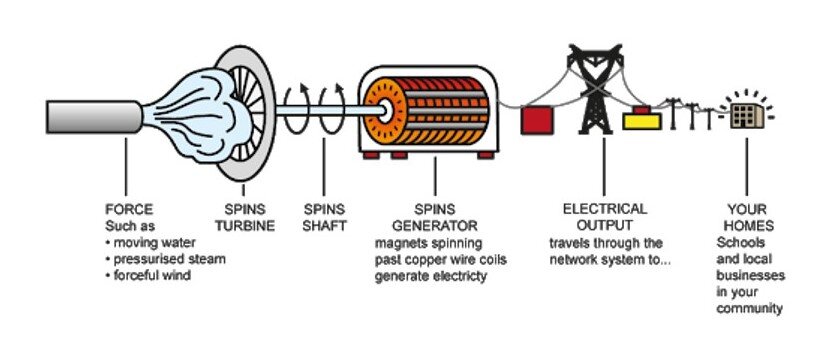Tech Breakdown: How is Electricity Generated?
By Kristen Abels
Imagine you are stranded on a deserted island; there happens to be a cell signal but your cellphone is at 1% battery and there is no outlet in sight. After a quick walk around the island, you note that there is a fast-flowing river, an abandoned coal mine (kind of strange for a deserted island), lots of wind, and an abundance of sunshine. You know that our society uses all of these forms of energy to generate electricity (the type of energy you so desperately need to charge your phone and call for help), but you have no idea how to go from one form to another. While this article won’t give you all the salient details required to build your own electricity generating station, it will give you a general understanding of how we convert these energy sources into the electricity we use every day.
Whether it’s hydro, coal, wind, or nuclear (pretty much everything except solar photovoltaic (PV) - that is, solar panels), the central piece of the puzzle in power generation is the generator. Simply put, a generator consists of a rotating magnet (often an electromagnet) surrounded by stationary coils of copper wire [1]. The rotation of the magnet creates a constantly changing magnetic field in the generator, which induces a voltage and therefore a flow of current in the coils of wire [2]. The key thing here is that we are not making electricity from nothing, we are merely converting from one form of energy – mechanical energy – to another.
A visual depiction of energy generation. Original image can be found here.
So, where does this mechanical energy come from? The rotation of the generator magnet is driven by a turbine. In wind and hydro, the kinetic energy of fast-flowing air and water turns the turbines, which, in turn, turns the generator to make electricity. In the case of chemical energy stored in fuels like coal, natural gas, and even biomass, we must do another conversion to go from chemical energy (heat) to mechanical energy (rotation of turbine) to electricity. For instance, in coal-fired power plants, the extreme heat generated from the combustion of coal is used to boil water into steam, which gets sent through a steam turbine. This turbine is connected to a generator to produce electricity, just like with wind and hydro.
With natural gas power plants and biomass gasification plants, the hot combustion gases are used to boil water into steam to drive steam turbines as well, but the gases themselves are also sent through a gas turbine beforehand to generate even more electricity in the process. This sort of set-up is called a “Combined Cycle” since gas and steam turbines are used in combination [3]. Either way, these types of plants fall into the thermal generation category since they rely on heat of combustion to produce electricity [4].
Nuclear power operates on much of the same principle, however the heat in nuclear power plants is not generated from combustion; instead, enormous amounts of heat energy are released from a chain reaction in which a radioactive material breaks down at the atomic level. Again, this is used to boil water into steam which gets sent through steam turbines to drive an electric generator – and you know the rest of the story.
Even solar thermal power plants raise steam by concentrating the sun’s rays to generate extreme heat – see the pattern here? While the steam turbine was first invented back in 1884, it is still used widely today to generate much of our electricity across a variety of power plant types [5]. One exception is with solar PV systems, which fall outside the thermal generation category. Instead, solar PV systems consist of solar panels made of specially-arranged semiconductor materials like silicon (an element commonly used in electronics), which convert solar energy directly to electricity [6].
So, heading back to our deserted island dilemma – if you happen to have a little electric generator on hand, or a portable solar PV cell in your back-pocket, you’re in good shape! If not, you have quite a bit of work to do to get electricity, the form of energy we so often take for granted. But hey, at least you know how the conversion is done in principle now!
References
[1] “How electricity is generated - U.S. Energy Information Administration (EIA),” 2019. [Online]. Available: https://www.eia.gov/energyexplained/electricity/how-electricity-is-generated.php. [Accessed: 09-Nov-2020].
[2] General Electric, “Electricity 101 | GE Power Generation,” 2020. [Online]. Available: https://www.ge.com/power/resources/knowledge-base/electricity-101. [Accessed: 08-Nov-2020].
[3] R. Ray, “Combined Cycle: The Preferred Option | Power Engineering,” Power Engineering Magazine, 2015.
[4] “How Electricity Generation Really Works — Practical Engineering,” 23-Jul-2019. [Online]. Available: https://practical.engineering/blog/2019/7/23/how-electricity-generation-really-works. [Accessed: 09-Nov-2020].
[5] “Electricity Generation using Steam Turbines.” [Online]. Available: https://www.mpoweruk.com/steam_turbines.htm. [Accessed: 09-Nov-2020].
[6] G. Knier, “How do Photovoltaics Work? | Science Mission Directorate,” NASA Science, 06-Aug-2008. [Online]. Available: https://science.nasa.gov/science-news/science-at-nasa/2002/solarcells/. [Accessed: 09-Nov-2020].
[7] Government of Canada, “Electricity facts,” 06-Oct-2020. [Online]. Available: https://www.nrcan.gc.ca/science-data/data-analysis/energy-data-analysis/energy-facts/electricity-facts/20068#L3. [Accessed: 09-Nov-2020].

